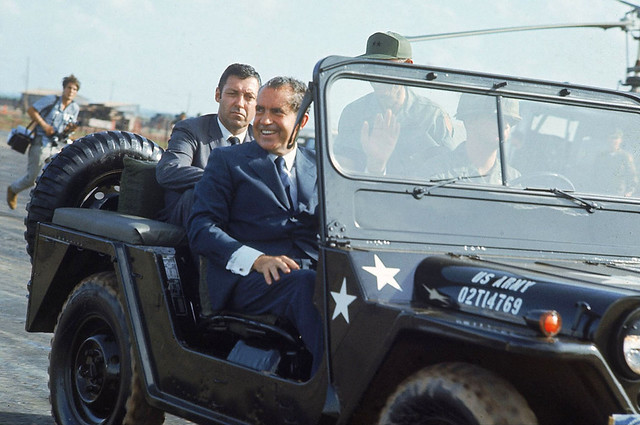
It’s a strange and poignant juxtaposition of anniversaries. On 24 July 1969 President Richard Nixon, just seven months into his presidency, was 1,500 kilometres southwest of Hawaii aboard USS Hornet to welcome the Apollo 11 astronauts back to earth and bask in the reflected glory of an American triumph.
From there he headed further west on his first trip to Asia as president. When his plane stopped to refuel in Guam, he held an informal press briefing—‘for attribution, but not for direct quotation’—to preview the trip for the travelling press. He spoke at some length and in a rather rambling way, but with deep knowledge and conviction, about Asia’s future and its significance to America.
He sought to reaffirm America’s commitment to Asia and its allies in the region. But he also qualified that commitment by setting new limits on what the US would be willing to do for its allies—hence making clear what it would expect its allies to do for themselves. This was clearest in Nixon’s answer to a question from one of the journalists.
[A]s far as the problems of military defense, except for the threat of a major power involving nuclear weapons, … the United States is going to encourage and has a right to expect that this problem will be handled by, and responsibility for it taken by, the Asian nations themselves.
This became known as the Guam doctrine, or the Nixon doctrine, which marks its 50th anniversary today. The president’s remarks were immediately seen as a major statement of US strategic policy, and he spelled it out more clearly in November 1969 in a televised address from the Oval Office:
First, the United States will keep all of its treaty commitments.
Second, we shall provide a shield if a nuclear power threatens the freedom of a nation allied with us or of a nation whose survival we consider vital to our security.
Third, in cases involving other types of aggression, we shall furnish military and economic assistance when requested in accordance with our treaty commitments. But we shall look to the nation directly threatened to assume the primary responsibility of providing the manpower for its defense.
The context, of course, was Vietnam. His aim was to avoid ‘the kind of policy that will make countries in Asia so dependent upon us that we are dragged into conflicts such as the one we have in Vietnam’. As Henry Kissinger made clear in his memoirs, there was no plan for Nixon to announce this new definition of America’s strategic role in Asia during that trip. But it was clear to everyone that such a redefinition was necessary.
Nixon himself at Guam described how Australia’s then prime minister John Gorton had told him that many leaders in Asia were wondering whether America was about to withdraw completely from the region, as France and Britain had done. Nixon’s aim was to reassure them that it wouldn’t, while at the same time reassuring Americans that there would be no more Vietnams.
Nixon’s Guam statement nonetheless landed as a very unreassuring bombshell in Canberra. Partly this was a matter of sequencing. The previous year prime minister Harold Wilson had announced the end of Britain’s role as a strategic power in Asia with the withdrawal of all British forces east of Suez. Australians had of course been aware of Britain’s declining strategic weight and influence for decades, but it nonetheless came as a shock that one of our two ‘great and powerful friends’ was giving up and going home.
Now, from Guam, Nixon seemed to be saying that the other one was doing the same. For a generation with vivid memories of the fall of Singapore, it seemed all too plausible that Australia was being deserted to look after itself. That generation knew their Kipling, too, and his poem ‘Recessional’ seemed to many eerily apposite.
More specifically, Nixon’s reformulation of America’s strategic commitment to its allies like Australia confirmed that we could not rely on its support to defend ourselves against our most serious credible threat. By limiting the US to helping defend allies facing nuclear-armed powers, Nixon made it clear that Australia was on its own in any conflict with Indonesia.
The Guam doctrine thus provided the decisive spur for Canberra to abandon forward defence in favour of self-reliance and the defence of Australia—a policy revolution that unfolded over the following decades culminating in the 1987 defence white paper, and which remains central to our defence policy today.
But of course Guam turned out to be something of a false alarm. Within three years Nixon revolutionised the Asian order by visiting Beijing. He transformed China—which at Guam he was still describing as ‘very belligerent and aggressive’—into a strategic asset, and thus made America the uncontested primary power in Asia. Then, in the early 1980s, under Ronald Reagan, America was keen to repudiate the Guam doctrine and reassert its strategic commitment to Asia as the Cold War entered its final bitter stages. And post–Cold War America’s commitment seemed to grow even stronger.
But now, of course, the old questions arise again. When he visits Washington soon, Scott Morrison could well say the same kinds of things to Donald Trump as Gorton said to Nixon. If he is brave enough, he too could report that many in Asia wonder whether America’s time there is drawing to a close as Britain’s and France’s did.
But this time those fears have deeper roots, because this time China’s belligerence and aggression are backed by an economy which today is not one-twentieth the size of America’s, but now rapidly overtaking it. And this time one has to ask: does Trump care about America’s place in Asia anyway?

